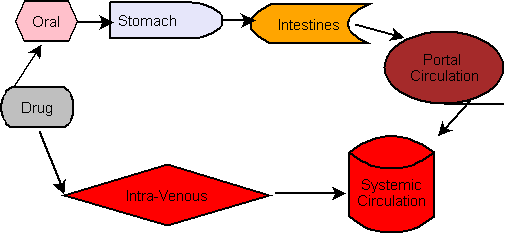Lesson 3: Sources of Drugs, Relevant processes and terms in drug intake, absorption metabolism and elimination
Contents
Introduction
Many drugs were discovered long ago by trial and error. Some were good and are still used today like the opium from the poppy tree, digitalis from the foxglove plant, etc. Discovery of medicinal plants was largely by chance and when tribal people looked for food they discovered various roots, leaves, and barks. The people ate, and, by trial and error, they learned about healing effects of these plants. They also learned about toxic effects. Today, there is a synthetic version of drugs to conserve their sources, for resource effectiveness, better dosage and control. We would learn about these sources of drugs in this lesson.
After the lesson student will:
|
Lesson Content
Sources of Drugs
- Primitive Medicine; Folklore, witchcraft, dreams, trances etc. Also from observing the reaction of some animals to particular herbs. Through primitive medicine quinine was discovered from Africa; used for malaria and limejuice for Ascorbic acid/Vitamin C and this is used for scurvy and gum bleeding.
- Plants; Roots, bark, sap, leaves, flowers, seeds were sources for drugs e.g. Reserpine from Rauwolfia Vomitora, Digitalis from foxglove, opium from the poppy plant.
- Animal sources; gave us hormones for replacement in times of deficiencies e.g. Insulin from the pancreases of pigs and cattle, Liver extracts for anemia etc
- Minerals; including acids, bases and salts like potassium chloride
- Natural; OCCURRING SUBSTANCES like proteins
- Happy Chance; Discovery is by chance not by any premeditated effort.
- Synthesis of Substances; from natural products in the laboratory.
Currently most drugs are synthetics produced in the laboratories with few from natural extractions.
Relevant Terms in Drug Intake, Absorption, Metabolism and Elimination
- Bioavailability; This is the proportion of administered drug, which reaches the circulation. Drugs given IV have high bioavailability whilst those given orally have to pass through the portal circulation so have lower bioavailability.
- Absorption; For the oral route this denotes how drugs pass through the stomach walls, intestines before entering the systemic circulation through the portal vein.The other routes of IV, IM, Subcutaneous, Sublingual, Inhalation, Rectal etc. get absorbed cells membranes and tissues.
- First-Pass; Drugs absorbed from the G.I. tract pass through the portal vein before the general circulation. They are metabolized and some get removed leaving only a proportion. Removal of the drug as passes through the liver is known as the first-pass. Drugs with high first-pass are inactive when swallowed e.g. glycerol dinitrate. They need to be given by other routes like IM, Sublingual or IV.
- Distribution; Movement of drugs from the blood to the tissues and cells
- Elimination or Excretion; Movement of the drug and its metabolites out of the body
- Metabolism; This is the process of breaking down the drugs by the liver and elimination of the foreign and undesirable compounds from the body
- Drug effects; this is the action of the drug which could be:
- Efficacy; which is the drugs ability to produce a desired chemical change in the body
- Tolerance refers to when the effects get lessened than desired due to abuse and the dosage must be increased.
- Adverse or side effects are undesired. They are unpleasant and/or harmful.
- Local effect is when drug does not get into the blood stream. The action is at the site of application.
- Systemic is when effect is throughout the body because the drug is absorbed into the bloodstream and distributed.
| Drugs have evolved over time. In times gone by, sources of drugs was not by rational methods yet they made sense to the discoverers and users. Choices were through observation and faith and some of the ingredients were absurd. The mode of action was not known, there were no researched and aunthetic therapeutic effect but most patients had psychological relief. Some of the discoveries stood the test of time and are still useful.
The second portion of our lesson demonstrated to us how drugs work after we take them. As they move along the body system we lose some, retain some but in the end they give us some effects. |
Aakwaamensah 17:44, 28 February 2007 (CET)
For more ionformation/practice/exercises click here[1]
